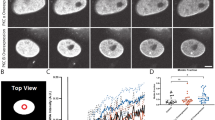Abstract
Protein kinase C-δ is activated during apoptosis, following proteolytic cleavage by caspase 3. Furthermore, overexpression of the catalytic kinase fragment of PKC-δ induces the nuclear phenotype associated with apoptosis, though the molecular basis of this effect has not been determined. In these studies we have examined the role of PKC-δ in the disassembly of the nuclear lamina at apoptosis. The nuclear lamina is disassembled during mitosis and apoptosis and mitotic disassembly involves hyperphosphorylation of lamin proteins by mitotic lamin kinases. During apoptosis, lamin proteins are degraded by caspase 6 and the contribution made by phosphorylation has not been proven. We show here that protein kinase C-δ co-localized with lamin B during apoptosis and activation of PKC-δ by caspase 3 was concomitant with lamin B phosphorylation and proteolysis. Inhibition of PKC-δ delayed lamin proteolysis, even in the presence of active caspase 6, whilst inhibitors of mitotic lamin kinases were without effect. In addition recombinant human PKC-δ was able to phosphorylate lamin B in vitro suggesting that its actions are direct and not via an intermediary kinase. We propose that PKC-δ is an apoptotic lamin kinase and that efficient lamina disassembly at apoptosis requires both lamin hyperphosphorylation and caspase mediated proteolysis.






Similar content being viewed by others
References
Bharti A, Kraeft S-T, Gounder M, Pandey P, Jin S, Yuan Z-M, Lees-Miller SP, Weichselbaum R, Weaver D, Chen LB, Kufe D and Kharbanda S . 1998 Mol Cell Biol 18: 6719–6728
Chen NY, Ma WY, Huang CS and Dong ZG . 1999 J Biol Chem 274: 15389–15394
Edwards SW and Hallett MW . 1997 Immunology Today 18: 320–325
Emoto Y, Manome Y, Meinhardt G, Kisaki H, Kharbanda S, Robertson M, Ghayur T, Wong WW, Kamen R, Weichselbaum R and Kufe D . 1995 EMBO J 14: 6148–6156
Evans CA, Lord JM, Owen-Lynch PJ, Johnson G, Dive C and Whetton AD . 1995 J Cell Sci 108: 2591–2598
Ghayur T, Hugunin M, Talanian RV, Ratnofsky S, Quinlan C, Emoto Y, Pandey P, Datta R, Kharbanda S, Allen H, Kamen R, Wong W and Kufe D . 1996 J Exp Med 184: 2399–2404
Good JA, Ziegler WH, Parekh DB, Alessi DR, Cohen P and Parker PJ . 1998 Science 281: 2042–2045
Griffiths G, Garrone B, Deacon E, Owen P, Pongracz J, Mead G, Bradwell A, Watters D and Lord JM . 1996 Biochem Biophys Res Commun 222: 802–808
Gschwendt M, Muller HJ, Kielbassa K, Zang R, Kittstein W, Rincke G and Marks F . 1994 Biochem Biophys Res Commun 199: 93–97
Hocevar BA, Burns DJ and Fields AP . 1993 J Biol Chem 268: 7545–7552
Hozak P, Sasseville AM-J, Raymond Y and Cook PR . 1995 J Cell Sci 108: 635–644
Hug H and Sarre TF . 1993 Biochem J 291: 329–343
Kaufmann SH . 1989 Cancer Res 49: 5870–5878
Kerr JFR, Wyllie AH and Currie AR . 1972 Br J Cancer 26: 239–257
Lee JY, Hannun YA and Obeid LM . 1996 J Biol Chem 271: 13169–13174
Melkonyan H, Sorg C and Klempt M . 1996 Nuc Acids Res 24: 35–57
Mikulits W, Dolznig H, Edelmann H, Sauer T, Deiner EM, Ballou L, Beig H and Mullner EW . 1997 DNA Cell Biol 16: 849–859
Moir RD, Montag-Lowy M and Goldman RD . 1994 J Cell Biol 125: 1201–1212
Monks CRF, Kupfer H, Tamir I, Barlow A and Kupfer A . 1997 Nature 385: 83–86
Norbury C, MacFarlane M, Fearnhead H and Cohen GM . 1994 Biochem Biophys Res Commun 202: 1400–1406
Orth K, Chinnaiyan AM, Garg M, Froelich CJ and Dixit VM . 1996 J Biol Chem 271: 16443–16446
Owen PJ, Johnson GD and Lord JM . 1996 Exp Cell Res 225: 366–373
Peter M, Nakagawa J, Doree M, Labbe JC and Nigg EA . 1990 Cell 61: 591–602
Scheel-Toellner D, Pilling D, Akbar AN, Hardie D, Lombardi G, Salmon M and Lord JM . 1999 Eur J Immunol 29: 2603–2612
Shi L, Nishioka WK, Th'ng J, Bradbury EM, Litchfield DW and Greenberg AH . 1993 Science 263: 1143–1145
Shimizu T, Cao C-X, Shao R-G and Pommier Y . 1998 J Biol Chem 273: 8669–8674
Srinvasula SM, Fernandes-Alnemri T, Zangrilli J, Robertson N, Armstrong RC, Wang LJ, Trapani JA, Tomaselli KJ, Litwack G and Alenmri ES . 1996 J Biol Chem 271: 27099–27106
Whelan RDH and Parker PJ . 1998 EMBO J 14: 6148–6156
Williams GT . 1991 Cell 65: 1097–1098
Yazaki T, Ahmad S, Chahlavi A, Zylberkatz E, Dean NM, Rabkin SD, Martuza RL and Glazer RI . 1996 Mol Pharmacol 50: 236–242
Yuan ZM, Utsugisawa T, Ishiko T, Nakada S, Huang YY, Kharbanda S, Weichselbaum R and Kufe D . 1998 Oncogene 16: 16430–16448
Acknowledgements
We are grateful to Dr N Chaudhary for the gift of the lamin antibodies and to Professor D Kufe for the GFP-tagged PKC-δ constructs. We thank Mike Salmon and Nick Henriquez for helpful discussion of the manuscript. This work was supported by grants from the Leukaemia Research Fund (T Cross and E Deacon), the MRC (G Griffiths) and The Royal Society (JM Lord).
Author information
Authors and Affiliations
Rights and permissions
About this article
Cite this article
Cross, T., Griffiths, G., Deacon, E. et al. PKC-δ is an apoptotic lamin kinase. Oncogene 19, 2331–2337 (2000). https://doi.org/10.1038/sj.onc.1203555
Received:
Revised:
Accepted:
Published:
Issue Date:
DOI: https://doi.org/10.1038/sj.onc.1203555
- Springer Nature Limited
Keywords
We’re sorry, something doesn't seem to be working properly.
Please try refreshing the page. If that doesn't work, please contact support so we can address the problem.




